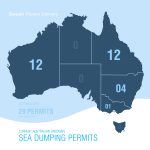In Australia, the relocation of clean sediment at-sea is regulated under the Environment Protection (Sea Dumping) Act 1981.
Organisations wishing to place dredged material at sea require a permit.
Learning more about sea dumping permits may help organisations who are considering applying to feel confident they understand their environmental and other obligations.
Swash has created a series of six graphic collections, sharing some key insights into Australian dredging sea dumping permits.
Download the complete Swash sea dumping permits graphic series.
Note, figures are correct as of early 2020. While some statistics may change over time, the broader information provided below remains relevant.
Insight 1 - current permits
There are 29 current sea dumping permits for the placement of dredged material at-sea in Australia.
Insight 2 - majority of permits for maintenance dredging
There are two types of dredging in Australia – capital and maintenance.
These are defined in the Australian National Assessment Guidelines for Dredging (NAGD).
Maintenance dredging is dredging to ensure that channels, berths or other port areas are maintained at their designed dimensions.
Capital dredging is dredging for navigation, to enlarge or deepen existing channel and port areas or to create new ones.
Capital dredging can also be for engineering purposes, such as to create trenches for pipes or remove material unsuitable for foundations.
Both types of dredging require a sea dumping permit if clean sediment is to be relocated at sea.
Out of 29 current sea dumping permits, 8 are for capital and 21 for maintenance dredging in Australia.
By sediment placement volumes, capital dredging permits make up around 45% of the total permitted dredging placement volume. And 99.9% of this volume is for permits in Western Australia.
Maintenance dredging permits make up the other 55%. Within this, Queensland permits account for over half of the maintenance dredged material placement volumes.
Insight 3 - how the regulators work together
We also dived a bit deeper into the various permit lengths and different regulators who oversee the sea dumping permits.
It’s at this point that clients often tell us they start to feel overwhelmed.
Please reach out if you would like to have a conversation about your specific project and how to navigate the permit process. And meanwhile, we’ve put together a bit of a summary of how all the relevant Commonwealth Regulators and Acts work together below.
In Australia, the Commonwealth Department of Agriculture, Water and the Environment (DAWE) assess sea dumping permit applications related to dredging under the Environment Protection (Sea Dumping) Act 1981. This department came into effect on 1 February 2020, and supersedes the Department of the Environment and Energy (DEE).
The Sea Dumping Act is related to the Environmental Protection and Biodiversity Conservation Act 1999 (EPBC Act), the Great Barrier Reef Marine Park (GBRMP) Act 1975 and the Sea Installations Act 1987.
The GBRMP Authority is responsible for assessing Sea Dumping (and Marine Park) permit applications within the GBRMP.
Insight 4 - environmental conditions
When it comes to mitigation measures for the protection of marine species during the dredging and sediment placement process, certain conditions will be applied to any permits you are granted.
There are two main conditions that are effectively common in all permits (see infographics below).
Insight 5 - management plans
As noted, there are a number of environmental considerations that may be conditioned in a dredging related sea dumping permit.
These conditions are usually managed through implementation of a (Long-term) Management and Monitoring Plan and Dredging Environmental Management Plans.
Seasonal dredging restrictions and operational procedures such as turtle exclusion devices are often included in these plans which form part of a permit application’s supporting documents.
Insight 6 - internal waters
The Sea Dumping Act does not apply where placement of dredged material is to occur entirely in ‘internal waters’, within the limits of a state or the Northern Territory.
Such waters include rivers, the gulfs in South Australia, and some bays, such as Sydney Harbour and Port Phillip Bay (Melbourne).
Internal waters may also include the landward side of the territorial sea baseline, where a straight line has been used between discrete points on the low-water line where the coastline is deeply indented and cut into (eg. Merimbula, NSW).
In all other scenarios, a permit is required under the Sea Dumping Act to authorise the placement, and the loading for the purposes of placement, of dredged material into Australian waters.
Australian waters typically extend from the low water mark out to the limits of the Exclusive Economic Zone (EEZ) or the Continental Shelf of Australia where it extends beyond the EEZ.
Get in touch
These graphics are intended to help everyone working in industry to understand some basics related to sea dumping permits.
If you’d like to talk more about your own project and permit requirements, please get in touch or connect with me on LinkedIn.



